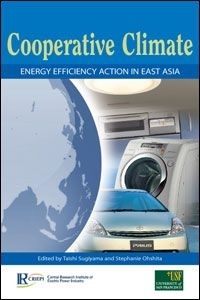Cooperative Climate: Energy Efficiency Action in East Asia (e-book)
Published: 2006, International Institute for Sustainable Development
Authors: Gørild Heggelund, Alan Meier, Stephanie Ohshita, Jonathan Sinton, Taishi Sugiyama, Stephen Wiel
PDF Version: Download (1.1 MB)
- Acknowledgements (Cooperative Climate: Energy Efficiency Action in East Asia (e-book))
- About the Authors
- Acronyms
- Executive summary
Part I: Introduction (Cooperative Climate: Energy Efficiency Action in East Asia (e-book))
Chapter 1. Climate Change, Asian Economy, Energy and Policy
by Taishi Sugiyama
- 1.1 Global Climate Policy at a Crossroads
- 1.2 Changing International Relationships in Asia: Economic Development, International Cooperation and Technology Transfer
- 1.3 Policy Development and Regulatory Harmonization: Opportunities
Chapter 2. The Need for Energy Efficiency Cooperation
by Taishi Sugiyama, Gørild Heggelund and Takahiro Ueno
- 2.1 What Energy Efficiency Can Do for East Asia – and the Planet
- 2.2 Domestic Political Context of Energy Conservation – Increasing Political Attention
- :: A. China’s current energy policy and political setting
- B. Current energy efficiency policies in East Asia
- C. Why domestic policies are the key to promoting energy efficiency
- 2.3 Common Interests in Energy Efficiency: Beyond the Climate Policy Stalemate
- 2.4 Why the CDM Cannot Deliver Massive Energy Savings
- A. Brief history of the CDM
- B. Can the CDM deliver energy efficiency?
- 2.5 Conclusion
Part II: Existing Energy Efficiency Cooperation in East Asia
Chapter 3. Cooperation Structure: The Growing Role of Independent Cooperation Networks
by Stephanie Ohshita, Steve Wiel and Gørild Heggelund
- 3.1 Experience from Bilateral Cooperation
- 3.2 Experience from Multilateral Institutions
- 3.3 Possibilities for Regional Cooperation
- 3.4 A New Model: Independent, International Cooperation Networks
- 3.5 Conclusions:The Growing Role of Independent Cooperation Networks
Chapter 4. Cooperation Mechanisms: A Shift Toward Policy Development Cooperation
by Stephanie Ohshita
- 4.1 Forms of International Cooperation on Energy Efficiency and Conservation
4.2 Lessons Learned from Technology Cooperation and Development Assistance
4.3 How Policy Development Cooperation Works
4.4 A Shift Toward Policy Development Cooperation
4.5 Conclusion: Policy Development Cooperation that Builds Capacity, Creates Incentives and Transforms Markets for Energy Efficiency
Chapter 5. Cooperation Targets: From Industry to Energy Services
by Stephanie Ohshita, Alan Meier, Steve Wiel and Gørild Heggelund
- 5.1 Industry Looms Large: Still Significant Potential for Energy Savings
- 5.2 Appliance Energy Efficiency: Saving Billions, One Watt at a Time
- 5.3 From the Ground Up: Building Efficiency
- 5.4 Serving End-Users:Creating Energy Service Companies (ESCOs) and Energy Management Companies (EMCs)
- 5.5 Improving Government Efficiency:Cooperation on Public Sector Procurement Policies
- 5.6 Integrated Strategies:Multi-Sectoral Efforts
- 5.7 Conclusion: Opportunities and Challenges in Cooperation Targets
Part III. Proposal for a New Energy Efficiency Policy Development Fund
Chapter 6. The Fund Proposal
by Taishi Sugiyama, Steve Wiel, Alan Meier and Jonathan Sinton
- 6.1 Key Design Issues
- :: A. Requirements of the Fund
- B. Political agreement
- C. Modality of the Fund
- D. Project coverage by the Fund
- 6.2 The Policy Development Fund
- :: A. The Fund Proposal
- B. Example projects
- C. Political feasibility with key stakeholders
- D. Cost-effectiveness of the Fund
- E. A future scenario
- 6.3 Summary
A Final Word from Co-editor, Taishi Sugiyama
References (Cooperative Climate: Energy Efficiency Action in East Asia (e-book))
